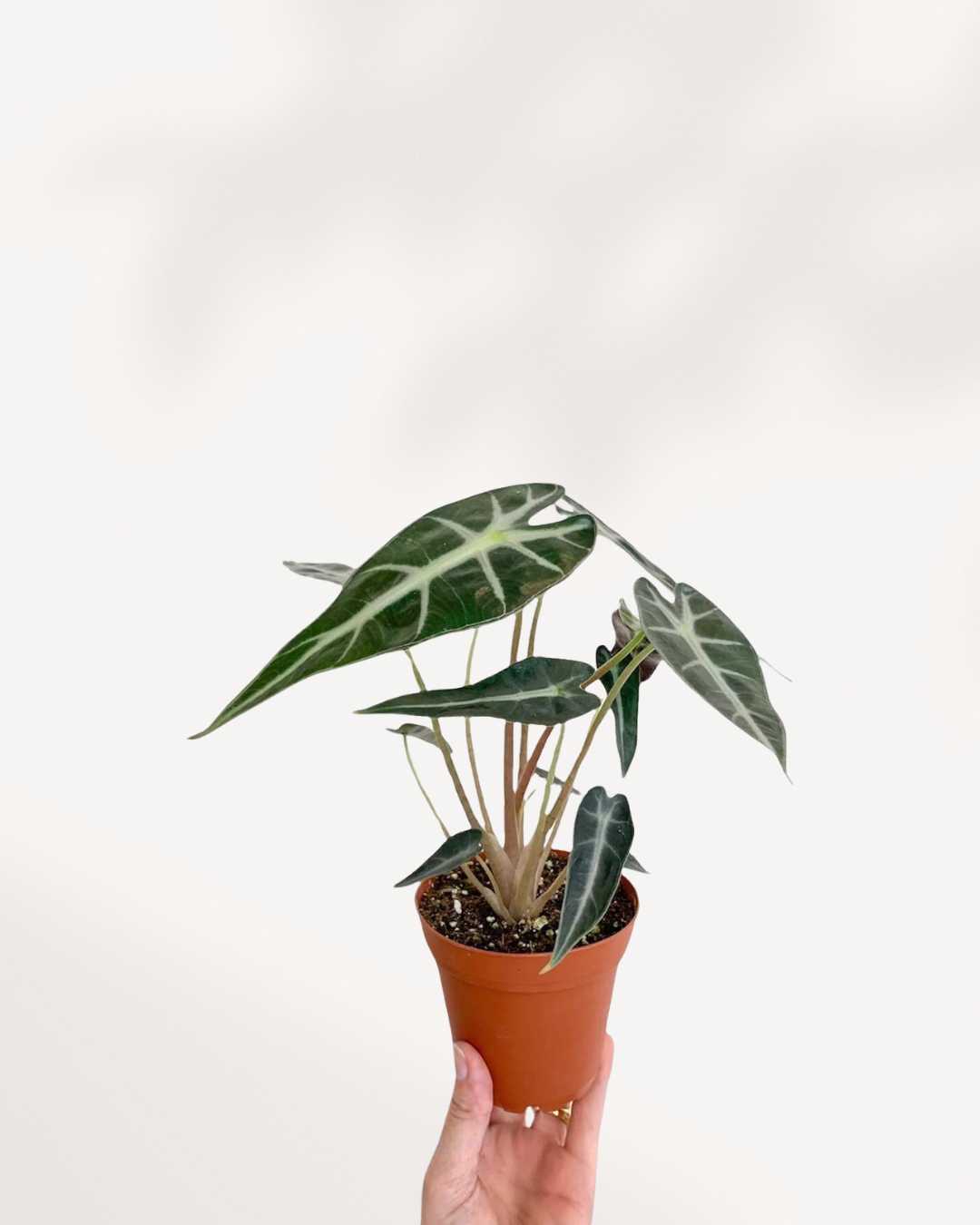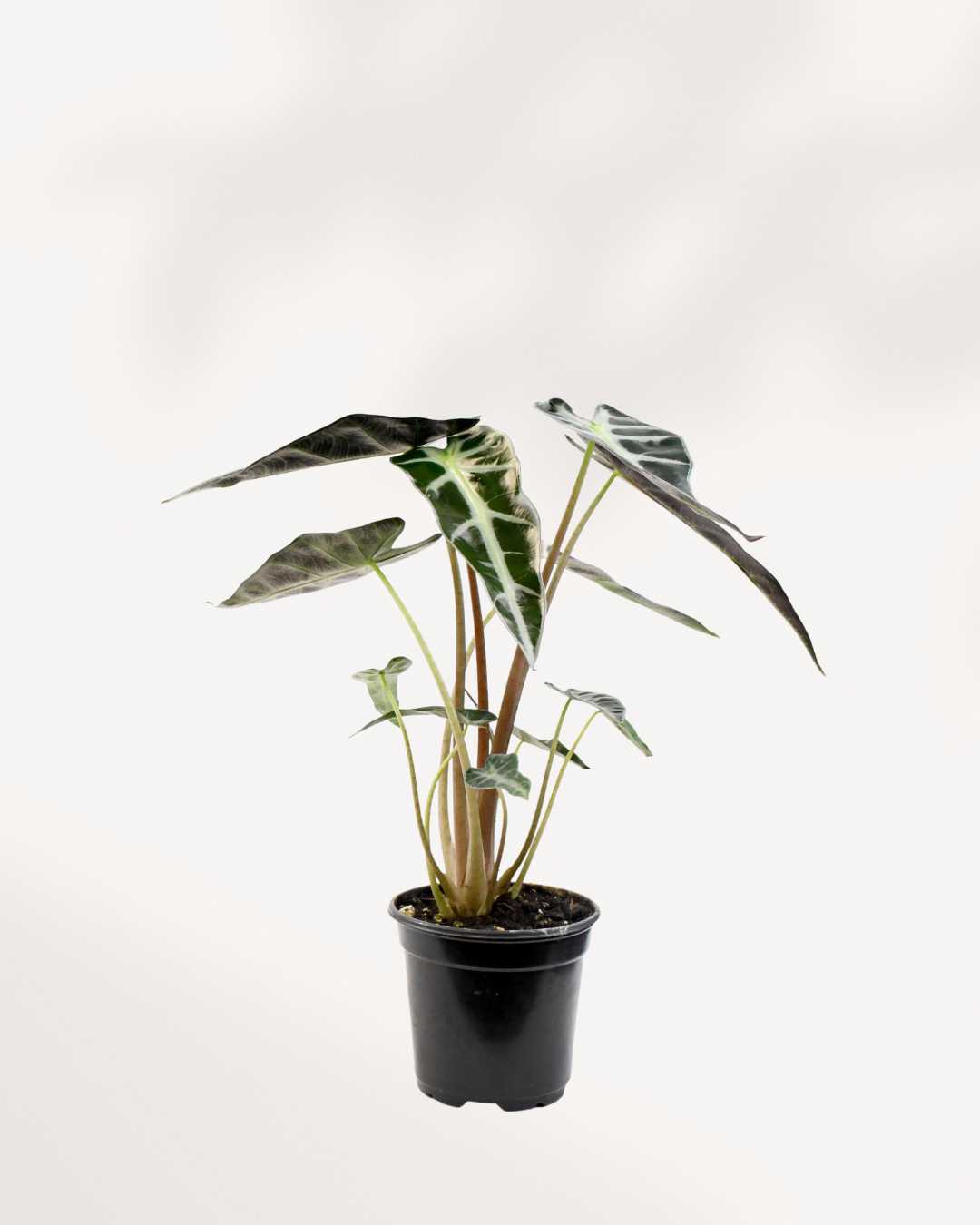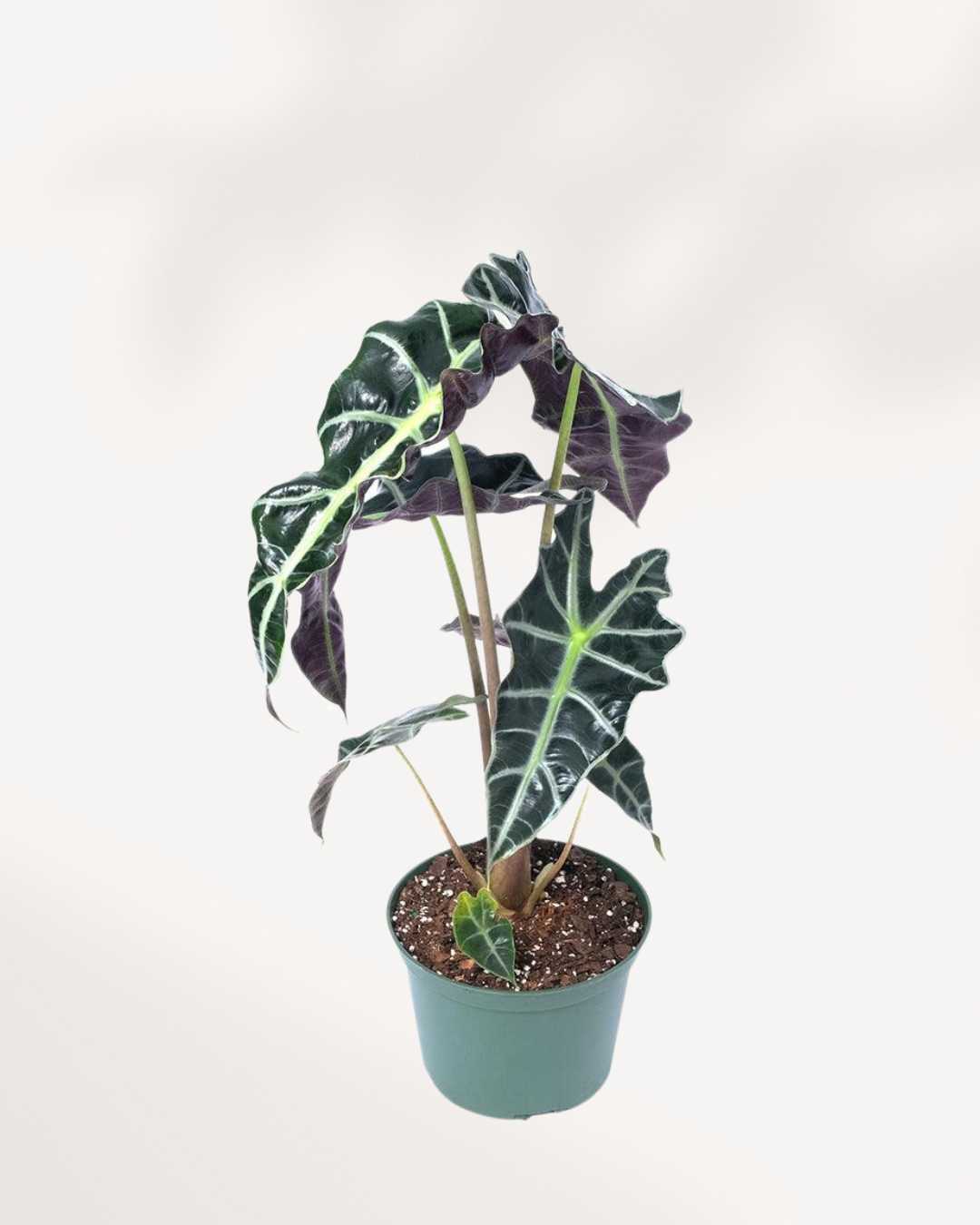Alocasia Bambino – A Compact Beauty with Bold Leaves
Alocasia Bambino – A Compact Beauty with Bold Leaves
Couldn't load pickup availability
Alocasia Bambino – A Compact Beauty with Bold Leaves
The Alocasia Bambino is a small plant with arrow-shaped, dark green leaves. It has striking white veins that make it stand out. Even though it is small, it adds a lot of beauty. It’s perfect for desks, shelves, or corners that need a little tropical style.
Why You'll Love Alocasia Bambino
-
Small size but big on beauty, great for small spaces
-
Helps clean the air and adds moisture to the room
-
Sculptural leaves give it a modern look
- Easy to care for with the right light and water
Common Names
- Alocasia Bambino
- Bambino Arrow
- Alocasia Bambino Arrow
Botanical Classification
- Kingdom: Plantae
- Order: Alismatales
- Family: Araceae
- Genus: Alocasia
- Species: Hybrid (Alocasia x Amazonica)
Origin of Alocasia Bambino:
Alocasia Bambino is native to Southeast Asia, specifically in tropical regions like Indonesia and the Philippines. It thrives in humid, tropical environments and is known for its compact size and striking, arrow-shaped leaves.
Benefits of Alocasia Bambino:
- Air Purification: Helps filter out toxins and improve indoor air quality, making your space feel fresher.
- Low Maintenance: Easy to care for with just occasional watering and indirect light, perfect for beginners.
- Aesthetic Appeal: Its compact size and bold, arrow-shaped leaves add a unique touch to any space.
- Improves Humidity: Like many tropical plants, it helps increase humidity levels, which benefits skin and respiratory health.
- Stress Reduction: Having greenery like Alocasia Bambino in your space can reduce stress and create a calming atmosphere.
Description
Appearance
Alocasia Bambino has arrow-shaped, dark green leaves with bold, contrasting white veins. Its compact stems hold the leaves upright, creating a tidy and architectural silhouette perfect for indoor display.
Growth Habit
Grows 12–18 inches tall, maintaining a compact and upright form. Ideal for small spaces or grouped with other tropical plants for a layered look.
Popular Alocasia Varieties
Alocasia Dragon Scale
- Large, textured leaves with dramatic white veining, resembling dragon scales.
Alocasia Black Velvet
- Dark, velvety foliage with contrasting white veins, a striking addition to any collection.
Alocasia Frydek
- Arrow-shaped, velvety leaves with bold white veining for a lush look.
Alocasia Regal Shield
- Large, shield-like leaves with deep green tones and contrasting veins, perfect for floor placement.
Dealing with Pests
Whiteflies
Monitor leaves and remove pests manually. For detailed prevention, see Whitefly Prevention.
Aphids
Wipe leaves or use insecticidal soap. Learn more at Battling Aphids Guide.
Fungus Gnats
Allow the top inch of soil to dry between waterings. Guide: Fungus Gnat Control.
Thrips
Regular inspection and neem oil treatment helps. More info: Thrips Guide.
Scale
Remove manually or treat with oils. Details: Scale Guide.
Spider Mites
Increase humidity and treat with insecticidal soap. Info: Spider Mite Guide.
Mealybugs
Remove manually with alcohol. Tips: Mealybug Guide.
Frequently Asked Questions
How much light does Alocasia Bambino need?
Bright, indirect light is ideal. Avoid direct sunlight to prevent leaf burn.
How often should I water it?
Keep soil moist but not soggy. Allow the top inch to dry between waterings.
Is it safe for pets?
No, Alocasia Bambino is toxic to cats and dogs. Keep out of reach.
Does it prefer humidity?
Yes, higher humidity supports vibrant foliage and reduces pest issues.
Learn More About Alocasia Plant Care
Visit our Alocasia Plant Care Guide for detailed tips and instructions.
Add Tropical Elegance to Your Space
Order your Alocasia Bambino today and enjoy compact, sculptural foliage that elevates any indoor corner.
Order Yours NowIssues and their Fixes for Alocasia Bambino :
-
Yellowing Leaves: Overwatering or poor drainage.
Fix: Allow the soil to dry out between waterings and ensure the pot has good drainage. -
Brown Leaf Tips: Low humidity or underwatering.
Fix: Mist the leaves regularly and keep the plant in a humid environment. -
Leggy Growth: Insufficient light.
Fix: Move the plant to a spot with bright, indirect light to encourage healthy growth. -
Pest Infestation (Spider Mites): Small webs or yellow spots on leaves.
Fix: Wipe the leaves with soapy water or use an insecticidal spray to remove pests. -
Drooping Leaves: Underwatering or sudden temperature changes.
Fix: Water the plant thoroughly and avoid placing it in drafts or near heat sources.
Styling tips for Alocasia Bambino:
- Place on a Small Table: Its compact size makes it ideal for adding greenery to side tables, desks, or nightstands.
- Use a Decorative Pot: Choose a sleek or bold pot to highlight its unique, glossy, arrow-shaped leaves.
- Group with Other Tropical Plants: Pair it with other small, tropical plants to create a lush, indoor plant collection.
- Showcase on a Plant Stand: Elevate the plant on a stand to give it more presence and let its leaves stand out.
- Put it in a Bright Corner: Place it in a bright, indirect light area where its beautiful leaves can thrive and be admired.
How to take care of Alocasia Bambino
Light: Medium - Bright
Light: Medium - Bright
Sun: Indirect
Sun: Indirect
Water: When half dry
Water: When half dry
Humidity: High
Humidity: High
Pet Friendly: Caution
Pet Friendly: Caution
Pro Tip
Pro Tip
Delivery Policy for Plant Condition
Delivery Policy for Plant Condition
"I have only received part of my order. What to do?
No worries if you've only got part of your order! Our plants come from different nurseries and might arrive in separate shipments, typically 1-2 days apart. It's all part of ensuring your green friends reach you in top-notch condition!
If you do not receive the remaining packages within 48 hours contact support at info@mygreenscape.ca
What is the Life Time Support?
Absolutely! Lifetime support means you can count on us whenever you have questions or uncertainties about your plant. Whether you're puzzled by its behavior or just want to ensure it's thriving, we're here for you. Connect with us on Instagram @mygreenscapeto or shoot us an email at support@mygreenscape.ca.
When it comes to our guarantee for plants shipped with standard or express, rest assured that we offer a 30-day happy healthy plant guarantee on all such shipments. This ensures that your plants are covered for 30 days after delivery, giving you peace of mind regarding their condition. If you have any concerns within this period, feel free to reach out to us for assistance.
For further details, please visit our Local Delivery, Store Pickup, Standard Shipping Guide Page.
What to expect
What to expect
Your plant will arrive in a standard nursery pot, typically 0.5" - 1" smaller than the stated size to seamlessly fit into your chosen decorative pot. Washable Paper Planter Bags are available for separate purchase.
Just like nature intended, each plant is unique, showcasing natural variations in size, shape, and characteristics. Our commitment is to deliver a plant that closely resembles the one featured on our website, matching your chosen size, and with the potential to thrive happily in your home.
Frequently Asked Questions
Frequently Asked Questions
Certainly! If you're pondering about ordering plants online, you're not alone. We've compiled the most frequently asked questions. Check out our FAQ section here for quick answers! Happy planting!
Plant & Pot Size Chart
Plant & Pot Size Chart
Choosing the right pot size for your plants can be a daunting task, especially if you're new to gardening. But fear not! Our pot sizes chart can help you find the perfect match for your plants, ensuring they have enough space to grow and thrive. With our guide, you'll be able to confidently choose the right pot size and plant variety for your gardening needs.
Plant Pot Size Guide.

| Extra Small | 7-10 cm | 2.5 - 3 inches |
| Small | 11-12 cm | 3.5 - 4 inches |
| Medium | 14-17 cm | 5 - 6 inches |
| Large | 19-21 cm | 8 - 10 inches |
| Extra Large | 24-27 cm | 12 - 14 inches |
All sizes are specified in product details.
Your Complete Guide to Pot Sizes: What Size Should You Choose?

When selecting a pot for your plant, it's important to find the right size. But with all the different options out there, how do you know which one is best? We're here to help!
MyGreenscape's pot sizes chart is a great resource for finding your perfect fit. Our easy-to-read chart takes out all the guesswork and helps you quickly choose the right size for your plant.
Smaller pots are best for seedlings or small plants just starting out. These tend to be shallow but wide, allowing enough room for the roots of the young plant but not too much where they get overcrowded. Medium-sized pots are ideal when your plant has grown from its infancy and is ready for more space. These are deeper and wider than small pots, so that it can accommodate larger root systems - making sure your plant gets enough nourishment while still giving it breathing room. Large pots are top choice if you have an established plant in need of lots of space - think trees and large shrubs! The spacious depth and width allow plenty of room for deep root systems without struggling for air or light.
No matter what size you choose, MyGreenscape has got you covered, with our pot sizes chart guaranteeing you find the perfect fit every time!
Winter Shipping Protection
Winter Shipping Protection
We take extra care with each package during the colder months. For destinations experiencing cold weather, we provide insulated packaging and heat packs as needed to protect your plants from freezing temperatures. With Winter Shipping Protection, your plants are equipped to arrive safe and sound, even in winter’s chill.
Care Guide
Care Guide
Explore essential care tips. check out our Comprehensive Resource for Indoor Plant Care.




WATERING MADE EASY
Check soil moisture before watering and use a potting mix that drains well. It’s the secret to healthy, happy plants!
Hear From Happy Plant Parents.
Who have brought Mygreenscape plants into their homes.


















